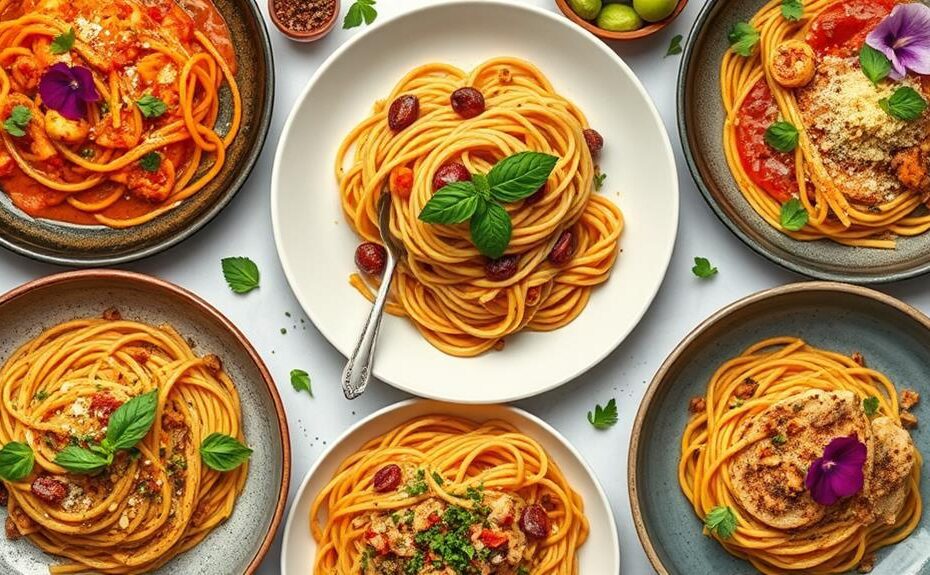Experience the Flavors of the Philippines with These 10 Delicious Pasta Variations
The Philippines offers a diverse range of pasta dishes that blend traditional flavors with international influences. Filipino pasta variations combine sweet, savory, creamy, spicy, and bold flavors to satisfy any craving.
Sweet and Savory Options
Filipino spaghetti dishes are known for their sweet and savory flavors. Jollibee-Inspired Sweet Spaghetti is a popular variation that combines sweet-style sauce with a classic spaghetti dish.
Another option is Sweet-Style Filipino Spaghetti With Corned Beef, which adds a savory element to the sweet sauce.
Rich and Creamy Options
For those who prefer rich and creamy pasta dishes, Creamy Filipino Carbonara Delight is a must-try. This variation adds a Filipino twist to the classic carbonara recipe.
Filipino Chicken Fettuccine Alfredo is another creamy option that combines chicken with a rich and flavorful Alfredo sauce.
Spicy and Bold Variants
For those who like a little heat, Spicy Filipino Spaghetti With Sausage is a great option. This variation adds a spicy kick to the classic spaghetti dish.
Palabok-Style Filipino Noodle Dish is another bold option that combines a sweet and savory sauce with a variety of toppings.
Filipino Spaghetti With Crab Fat Sauce is a unique variation that adds a rich and flavorful sauce to the classic spaghetti dish.
These 10 Filipino pasta variations offer a range of flavors and options to satisfy any craving.
Jollibee-Inspired Sweet Spaghetti
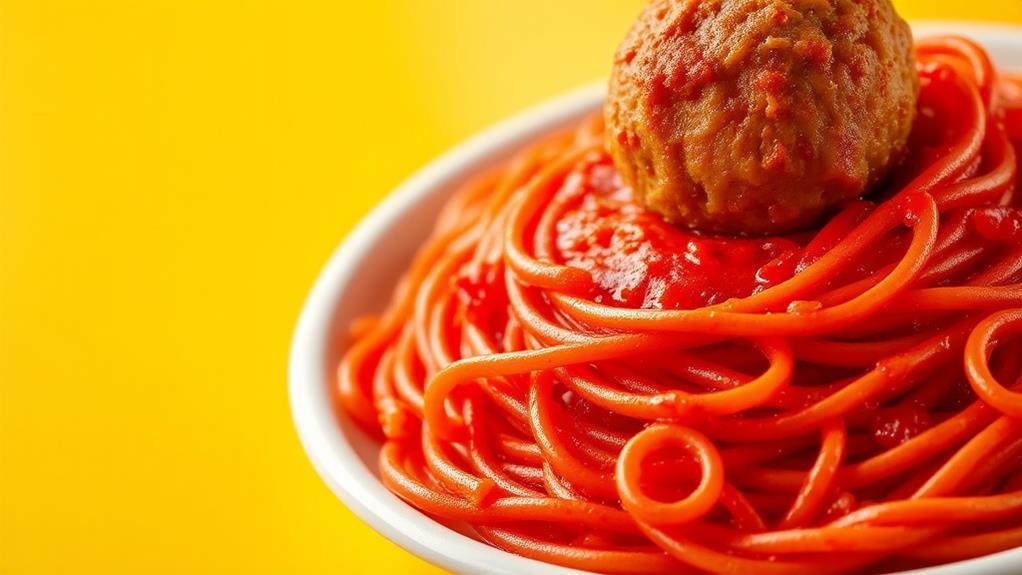
The Jollibee-Inspired Sweet Spaghetti is a beloved Filipino dish that brings people together. This sweet and savory spaghetti is a staple in many Filipino households due to its unique flavor profile.
The sweetness from banana ketchup and savory meat sauce made with ground beef and sliced hot dogs create a flavor combination that's both familiar and indulgent.
The dish is made rich and creamy with grated quick-melt cheese. This adds a richness that enhances the overall flavor, making it a comfort food that's hard to resist.
The slow-cooked sauce is rich and hearty, with optional ingredients like diced ham or bell peppers adding texture and taste.
This sweet Filipino spaghetti is a favorite at birthday parties and special occasions in the Philippines. It evokes nostalgia and brings people together, which is why it's a staple in many Filipino households.
Creamy Filipino Carbonara Delight
The Creamy Filipino Carbonara Delight: A Rich Twist on a Classic
The Filipino version of carbonara stands out from the traditional Italian recipe due to its unique blend of flavors and textures.
The Creamy Sauce
The sauce in Filipino carbonara is enriched with evaporated milk or heavy cream, giving it a luxurious feel. This rich base is flavored with garlic and sometimes sautéed onions and mushrooms, complementing the sweetness of Filipino cuisine.
A Harmonious Balance of Flavors and Textures
Imagine tender spaghetti strands smothered in a rich, velvety sauce. The savory flavors of garlic, onions, and mushrooms mingle together, while the creaminess of evaporated milk or heavy cream balances out the dish.
The crispy bacon or ham adds a satisfying crunch to each bite.
A Distinctive Flavor Profile
Unlike traditional carbonara, the Filipino version often incorporates processed cheese for creaminess and a distinctive flavor profile.
This dish is a staple at family gatherings and celebrations, embodying the Filipino love for rich, flavorful meals that resonate with comfort and nostalgia.
Spaghetti With Filipino-Style Meatballs
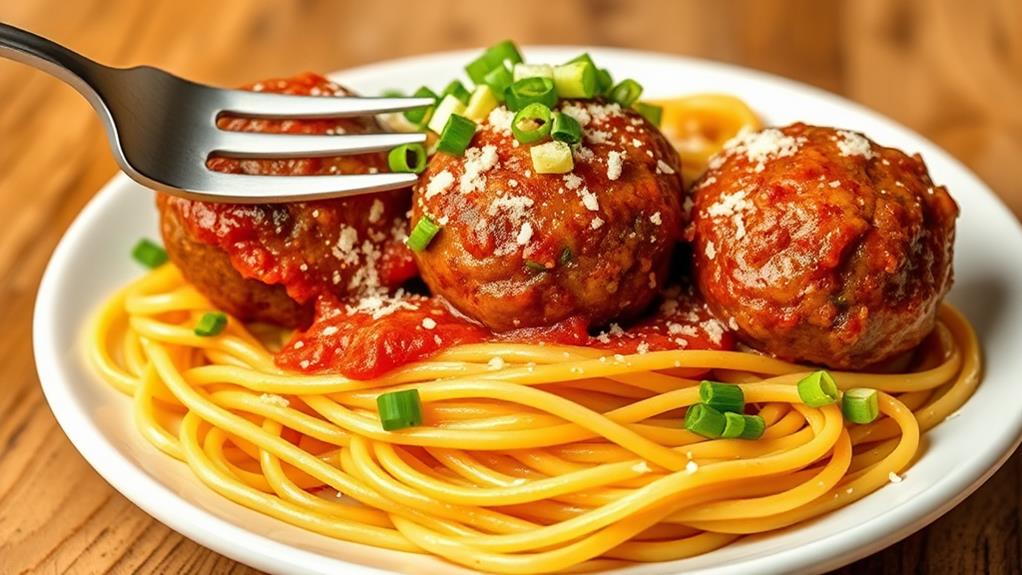
Spaghetti with Filipino-Style Meatballs: A Unique Twist on a Classic Dish
Spaghetti with Filipino-style meatballs, also known as "albóndigas," is a beloved Filipino pasta variation. These meatballs are made from a blend of ground pork and beef, seasoned with garlic, onion, and local spices. The mixture is then shaped into small balls and fried or baked to add flavor.
The meatballs are simmered in a sweet and savory tomato sauce infused with banana ketchup, which gives the dish its distinct Filipino flavor. When served over spaghetti noodles, the meatballs absorb the sauce, creating a hearty and satisfying meal perfect for families and celebrations.
To add richness and depth to the dish, sprinkle shredded cheese, such as quick-melt or grated processed cheese. This popular Filipino adaptation is often served at children's parties and gatherings, showcasing the unique blend of Filipino culinary traditions and comfort food.
Sweet-Style Filipino Spaghetti With Corned Beef
Sweet-Style Filipino Spaghetti with Corned Beef: A Twist on Traditional Spaghetti
This dish is a unique variation of traditional spaghetti, balancing sweet and savory flavors in a rich and innovative sauce.
The sauce is made from a combination of banana ketchup and tomato sauce, creating a sweet and tangy flavor profile.
Sautéed garlic and onions add a savory aroma, while ground corned beef provides a meaty depth to the dish.
The addition of sliced hot dogs adds a pop of color and a salty flavor, cutting through the sweetness of the sauce.
The velvety texture of the sauce coats every strand of spaghetti, infused with the deep flavor of simmered corned beef.
A generous sprinkle of grated cheese adds a creamy element to the dish, completing this comforting meal.
This Sweet-Style Filipino Spaghetti with Corned Beef is a testament to the creativity and resourcefulness of Filipino cuisine, offering a delicious twist on traditional spaghetti.
Filipino-Style Spaghetti Bolognese
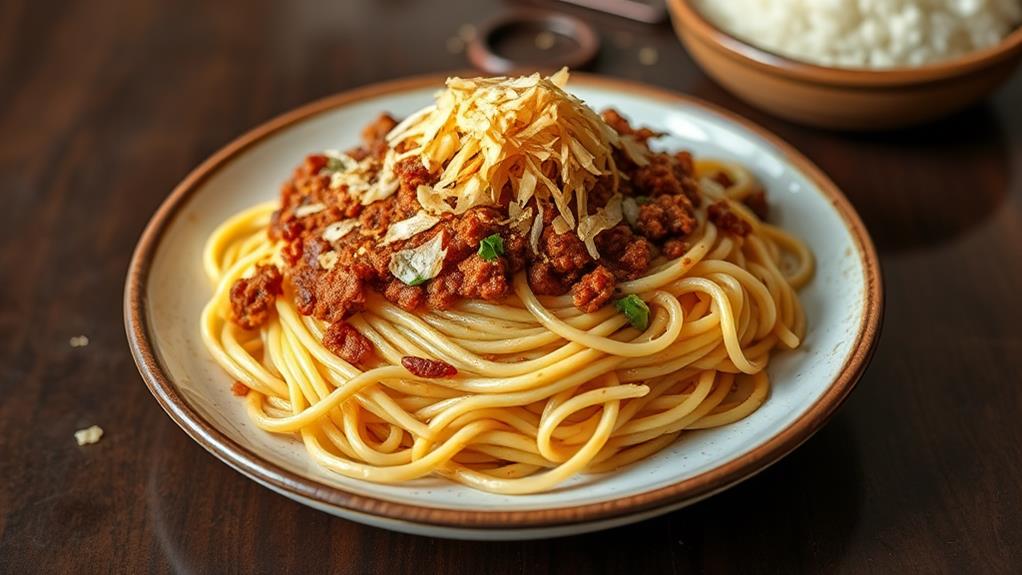
Filipino-Style Spaghetti Bolognese: A Twist on the Classic
This dish is a unique variation of the traditional Italian spaghetti Bolognese, originating from the Philippines. It combines ground meat with tomato sauce and banana ketchup, resulting in a sweet and savory flavor profile.
| Ingredients | Description |
|---|---|
| Ground beef | Rich source of protein |
| Tomato sauce | Tangy and slightly sweet |
| Banana ketchup | Sweet and fruity twist |
| Spaghetti noodles | Long, thin, and perfect for twirling |
| Grated cheese | Melts beautifully, adding richness |
The Flavor Profile
When you take a bite, the sweetness of the banana ketchup harmonizes with the savory flavor of the ground meat, while the spaghetti noodles provide a satisfying texture. Adding sliced hot dogs or Longganisa adds an extra layer of flavor and nostalgia, making this dish a staple comfort food in the Philippines.
Why You Should Try It
With its rich taste and appealing presentation, Filipino-Style Spaghetti Bolognese is a must-try recipe for anyone looking to spice up their pasta game.
Pancit Bihon With Vegetarian Twist
Pancit Bihon With Vegetarian Twist is a popular Filipino dish that has been adapted to cater to the growing demand for plant-based options.
This stir-fry dish is highly versatile and can be customized with a variety of colorful vegetables, including crunchy carrots and cabbage for added texture, vibrant bell peppers for a burst of juicy sweetness, and fresh green onions for a pop of color and flavor.
The savory sauce, made with soy sauce, garlic, and onion, can be adjusted to suit individual taste preferences.
To add protein, tofu or tempeh can be included, making it a satisfying meal for vegetarians.
This dish is ideal for special occasions and its adaptability to different dietary preferences makes it a crowd-pleaser.
Spicy Filipino Spaghetti With Sausage
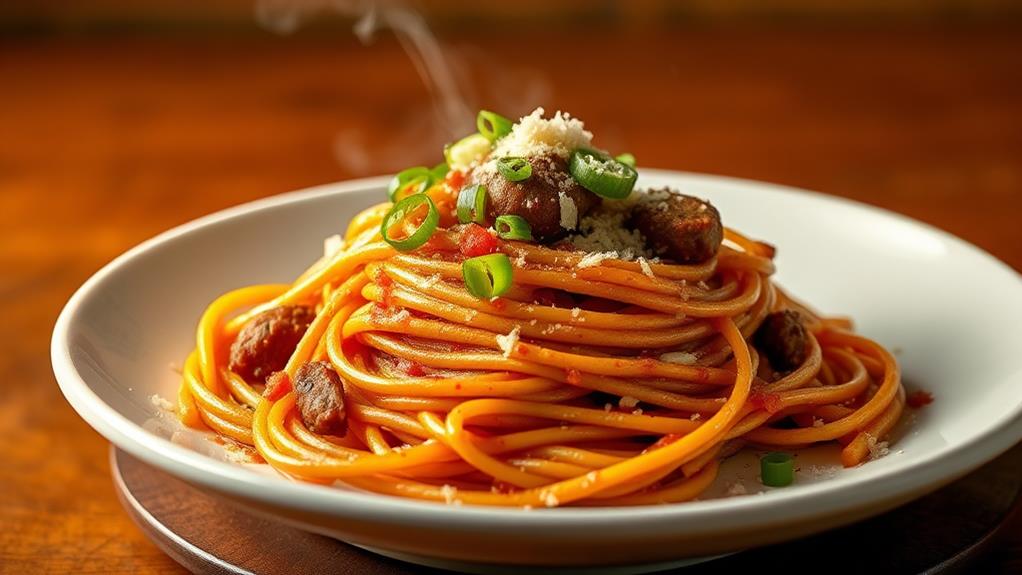
Spicy Filipino Spaghetti With Sausage: A Bold Twist on a Classic
This variation of traditional Filipino spaghetti stands out with its perfect balance of heat and richness, igniting taste buds with a unique flavor profile.
The combination of ground beef and sliced spicy sausage creates a bold, meaty flavor. The sauce, a masterful blend of banana ketchup, tomato sauce, and chili flakes or fresh chilies, skillfully balances sweetness with a spicy kick.
Enhancing the Flavor Profile
Cooking the sausage until browned before mixing it with sautéed onions and garlic enhances the flavor profile of the dish.
This step brings out the savory flavors of the sausage and aromatics.
Elevating the Dish
Topping the spaghetti with quick-melting cheese adds creaminess and helps to mellow the spice.
This addition balances the heat and richness, making the dish more appealing to a wider range of palates.
A Crowd-Pleasing Dish
Spicy Filipino Spaghetti With Sausage is a crowd-pleaser, often served at gatherings and family meals.
This dish caters to those who enjoy a spicy twist on classic Filipino spaghetti, satisfying cravings with its bold flavors and perfect balance of heat and richness.
Filipino Chicken Fettuccine Alfredo
Filipino Chicken Fettuccine Alfredo: A Rich and Creamy Twist
Filipino Chicken Fettuccine Alfredo offers a rich, creamy, and indulgent alternative to spicy dishes. This dish features tender chicken breast pieces sautéed in a sauce made from butter, cream, and Parmesan cheese, enhancing its flavor.
A Unique Flavor Profile
The fettuccine is coated with a savory sauce infused with garlic and onions, giving it a distinct twist from traditional Italian Alfredo. Additionally, a hint of sweetened condensed milk is added, reflecting Filipino culinary preferences, which balances out the dish with a touch of sweetness.
A Well-Rounded Meal
Filipino Chicken Fettuccine Alfredo is typically served with a side of garlic bread, perfect for dipping into the remaining sauce. This creamy pasta dish appeals to both children and adults, making it a popular choice for celebrations and festive meals.
Palabok-Style Filipino Noodle Dish
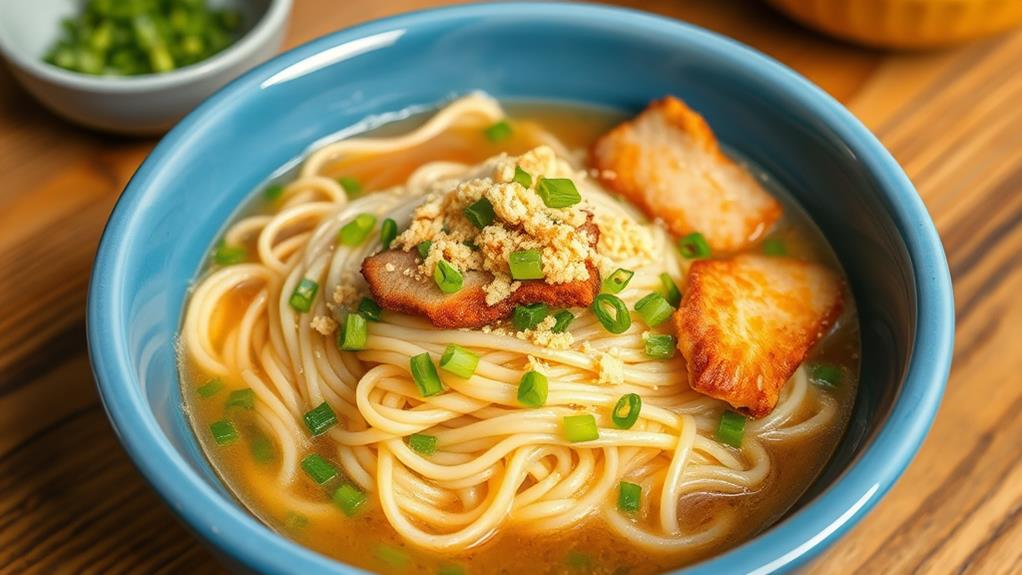
Palabok-Style Filipino Noodle Dish: A Traditional Comfort Food
Palabok-Style Filipino Noodle Dish is a vibrant and flavorful comfort food that has captured the hearts of many.
It is made with rice noodles and topped with a rich and savory sauce, typically made from shrimp broth, garlic, and fish sauce. This combination of ingredients creates a depth of flavor that's hard to resist.
The sauce is what sets Palabok apart, as it gets its vibrant orange color from the use of achuete (annatto seeds).
To add texture and visual appeal, Palabok is often garnished with a variety of toppings, including hard-boiled eggs, crispy pork skin, green onions, and sometimes a sprinkle of smoked paprika.
While traditionally made with shrimp, Palabok can also be made with chicken or pork, allowing for diverse interpretations of this beloved comfort food.
This versatility makes Palabok a dish that can be enjoyed by many.
What Makes Filipino Pasta Dishes So Satisfying?
Filipino pasta dishes are a delightful fusion of flavors that make them a musttry for any foodie. The combination of local ingredients like coconut milk, shrimp, and calamansi creates a unique and satisfying taste. From creamy baked macaroni to spicy pancit palabok, these musttry filipino pasta dishes are sure to please any palate.
Filipino Spaghetti With Crab Fat Sauce
Filipino Spaghetti with Crab Fat Sauce is a rich and indulgent dish that combines seafood flavors with traditional pasta.
This Filipino twist on spaghetti features a creamy sauce made from crab fat, garlic, onions, and tomato sauce, which creates a savory and umami flavor profile. The crab fat gives the sauce a unique seafood flavor that sets it apart from traditional spaghetti dishes.
The dish typically includes a medley of seafood flavors, such as shrimp or other seafood, which add depth to the sauce.
To soak up the rich sauce, a side of garlic bread is often served. A refreshing contrast can be added with a side salad or a sprinkle of grated cheese.
Filipino Spaghetti with Crab Fat Sauce is perfect for special occasions and family gatherings due to its indulgent flavors and satisfying portions.
Frequently Asked Questions
Can Filipino Pasta Variations Be Made With Gluten-Free Noodles?
Yes, Filipino pasta variations can be made with gluten-free noodles, but some adjustments are necessary.
To start, choose gluten-free noodle options like rice-based or quinoa noodles as alternatives to traditional pasta.
Focus on flavor enhancements such as spices, herbs, and acidities to maintain the flavor profile of your dish. For example, add a pinch of ground cumin or coriander to give your pasta a distinct Filipino flavor.
Adjust cooking techniques to prevent overcooking, which can make gluten-free noodles unappetizing. Cook noodles al dente and drain them immediately to prevent sogginess.
Consider ingredient swaps to accommodate gluten-free diets. For instance, use coconut milk instead of heavy cream to add richness and creaminess to your pasta sauce.
Are Filipino Pasta Dishes Typically Served as Main Courses?
Filipino pasta dishes aren't always served as main courses. While some can hold their own as a main course, others are better suited as a side.
The serving style depends on the occasion and regional culinary traditions. For instance, pesto-based pasta dishes can be served as a main course due to their bold flavor profile.
On the other hand, milder flavor profiles might be more suitable as a side dish.
Understanding the nuances of regional variations and flavor profiles is key to determining whether a Filipino pasta dish is served as a main course or a side.
Can I Substitute Filipino Spices With Italian Seasonings?
Filipino spices and Italian seasonings aren't interchangeable. These two cuisines have distinct flavor profiles, and substituting one for the other can disrupt the delicate balance of spices that define regional seasoning differences.
Filipino cuisine, for example, often combines sweet, sour, and salty flavors, with a focus on ingredients like patis (fish sauce), suka (vinegar), and bagoong (fermented fish paste).
Italian seasonings, on the other hand, typically feature herbs like basil, oregano, and thyme, which are commonly used to add depth and warmth to dishes.
Experimentation is key to creating a harmonious blend. If you want to combine elements of both cuisines, start by understanding the nuances of each and then thoughtfully experiment with different spice combinations.
This approach will help you create a unique flavor profile that respects both traditions.
Are Filipino Pasta Variations Commonly Served at Casual Gatherings?
Filipino pasta variations are commonly served at casual gatherings.
These gatherings can include family reunions, potlucks, or pasta parties. At these events, Filipino pasta dishes offer a unique twist on traditional flavors, making them an instant hit.
For instance, Spaghetti with Filipino-style meat sauce or Pesto pasta with grilled chicken and mango are popular choices.
While they may not be present at every casual gathering, they're always a crowd-pleaser when they do appear.
Can I Freeze Cooked Filipino Pasta for Later Consumption?
Yes, you can freeze cooked Filipino pasta for later consumption. However, it's crucial to follow the right techniques to preserve flavor and texture.
Cooling the pasta is essential to prevent moisture buildup. After cooking, let the pasta cool to room temperature before freezing.
Proper storage is vital. Portion the cooled pasta into airtight containers, making sure to remove excess air before sealing. This prevents freezer burn and maintains freshness.
Reheating correctly is key. When reheating, use gentle heat to prevent mushiness. This ensures the pasta retains its texture and flavor.
Freezing affects pasta texture, so it's essential to reheat correctly. By following these techniques, you can enjoy your Filipino pasta dishes while preserving their flavor.
